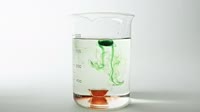A miracidium, a larval stage of the liver fluke (Fasciola hepatica), swimming among liver fluke eggs. Miracidia are tiny ciliated organisms which hatch from the fluke's eggs. They are attracted to certain species of freshwater snail, the liver fluke's secondary host. They penetrate the snail's tissues, and after further development, larvae called cercaria emerge. These form cysts on nearby vegetation, which are ingested by ruminants, or sometimes by humans. Immature flukes emerge from the cysts and migrate into the bile ducts. Here they reach maturity and pass eggs into the faeces, which contaminate water, thus continuing the fluke's life cycle. Liver flukes cause fascioliasis, a liver disease with symptoms including digestive problems, fever, pain, anaemia and jaundice. Footage filmed at Ridgeway Research, Gloucestershire, United Kingdom.
Details
WebID:
C01841086
Clip Type:
RM
Super High Res Size:
1920X1080
Duration:
00:00:11.000
Format:
QuickTime
Bit Rate:
25 fps
Available:
download
Comp:
200X112 (0.00 M)
Model Release:
NO
Property Release
No













 Loading
Loading